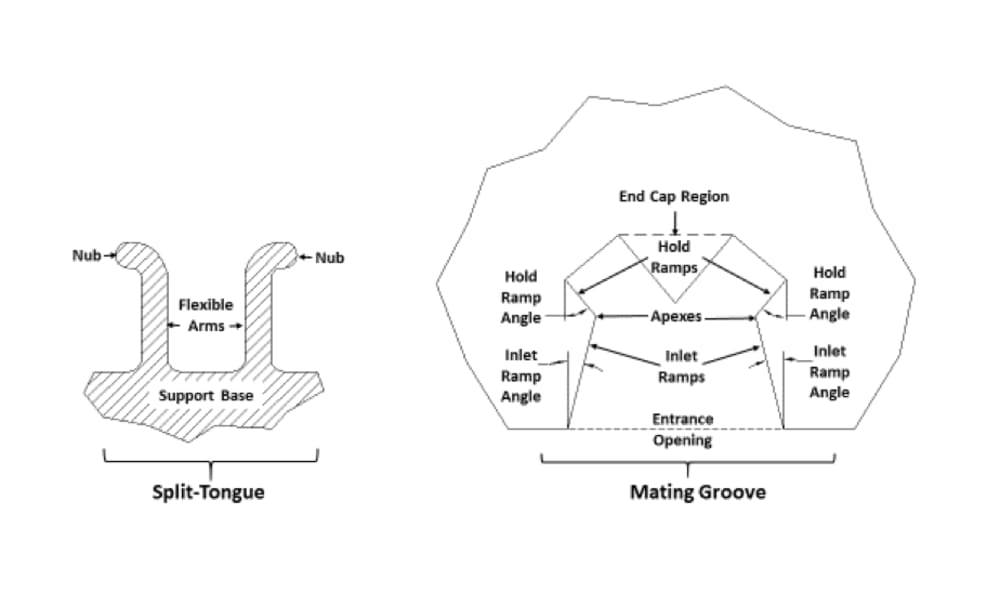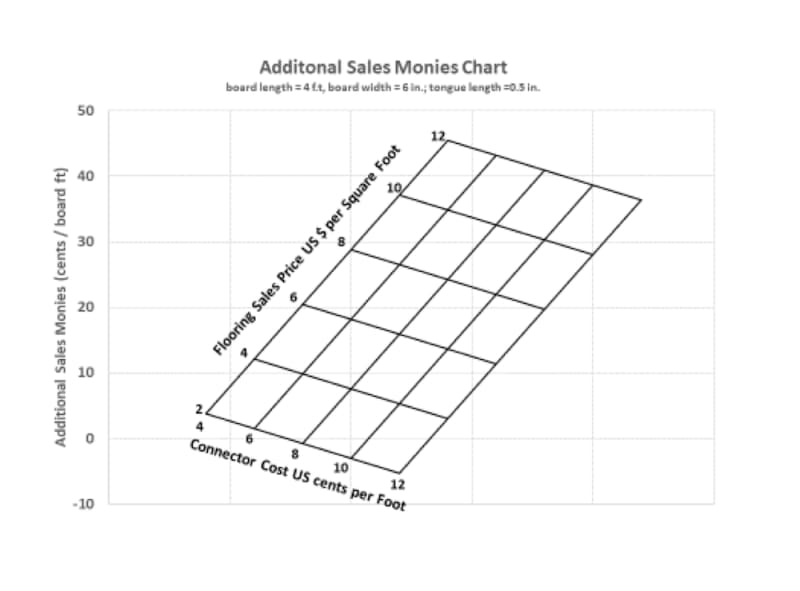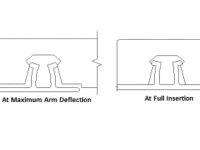Our Create the Future design entry is a revolutionary new, generic, mechanical fastener system based on the interaction of two key elements: a “split-tongue” and its mating groove, as shown in Figure 1.
The split-tongue consists of a support base with two protruding flexible arms, each arm have outward facing nubs at their distal ends. The mating groove consists of an entrance opening through which split-tongue enters the mating groove; converging opposed sidewalls (the inlet ramps); ; diverging opposed sidewalls (the hold ramps); with a minimum groove width at the groove apexes.
A potential application of the fastener system is as a connector system for installing hardwood flooring. For this application it is anticipated that the extruded connector element can be fabricated at a cost of approximately 4 cents per linear foot. However, for the connector system to be economically viable, it is critical that the associated mating groove be fabricated at economical production rates (typically 360 FPM). Consequently, it is proposed that the mating groove be fabricated via four sequential circular saw cuts as follows: one to form the left inlet ramp, a second to form the right inlet ramp, a third to form the right hold ramp, and a fourth to form the left hold ramp.
Figure 2 shows a split-tongue connector element at three stages during its installation into a mating groove fabricated into the bottom surface of a hardwood flooring plank. A key feature of the design is that at full insertion the flexible arms remain forcefully deflected. The accompanying video, demonstrates an installer utilizing the connector system to install a section of hardwood flooring into a hallway.
The above connector-based installation approach has three advantages relative to the tongue-in-groove installation system presently used to install hardwood flooring: 1) foremost to the flooring manufacturer, it avoids the loss of saleable hardwood surface associated with integral tongue fabrication; 2) it simplifies flooring installation; and 3) it simplifies flooring repair, since damaged flooring boards can be removed normal to the floor surface without disturbing adjacent boards.
The graph in Figure 3 shows the potential additional sales monies accrued (in US cents per linear foot of installed board) via advantage 1.
As the groove sidewalls apply horizontal deflection forces to the flexible arms, the insert and hold ramps generate associated vertical forces due to their inclination and friction. Four vertical forces of interest are: the maximum force resisting split-tongue insertion into, and the maximum force resisting split-tongue retraction from the groove; the force tending to pull the split-tongue into the groove and the force resisting the initiation of removal from the groove at full insertion.
A FORTRAN-90 PC based computer program calculates the cost, force, and critical geometric parameters of the hardwood flooring connector system. The code generates an AutoLisp file (to draw and dimension the connector and its mating groove via a 2D AutoCAD program) and an HTML file (to draw the connector and mating groove to the PC screen at the three conditions shown in Figure 2).
Video
Like this entry?
-
About the Entrant
- Name:Geoffrey Baker
- Type of entry:teamTeam members:Geoffrey Alan Baker Nicholas Gerard Vitale
- Software used for this entry:Simply Fortran
- Patent status:patented








